Kenya is one of the few countries in the world where you can experience an overwhelming diversity of wildlife. It is also here where nearly two million wildebeest and zebra annually wander across crocodile-infested rivers and endless plains – closely shadowed by the predators of the savannah. Join us on a safari that triggered several heart-pounding experiences.
Written by Mette / Photo by Martin
The article has been published for Africa Safari
Translated from Danish
Everything breathes peace in the small pond of water, just a few steps from us. It is empty, but there are clear traces of animals in the iron-red mud. Large animals. Heavy animals. “Look, they’re approaching,” says a man next to Martin, pointing towards the bush. Out of the thicket, a herd of young elephants comes running. The trunk swings from side to side, the ears flap, and their log-thick legs move as fast as they can. They have a direction towards the pond. Towards us.
We are standing on the edge of Nairobi National Park, where the elephant orphanage David Sheldrick Wildlife Trust is located. The organization is behind the world’s most successful rescue and rehabilitation program for endangered animals, and each day the doors are open to the public for one hour. The main attraction is to watch the elephants being fed.
The small group aims directly at five zookeepers, who are ready with wheelbarrows loaded with oversized baby bottles. “Oh, how cute,” two little girls giggle at the sight of the Dumbos greedily drinking from the bottles, sending white streaks of milk running down their thick, granite-grey skin.
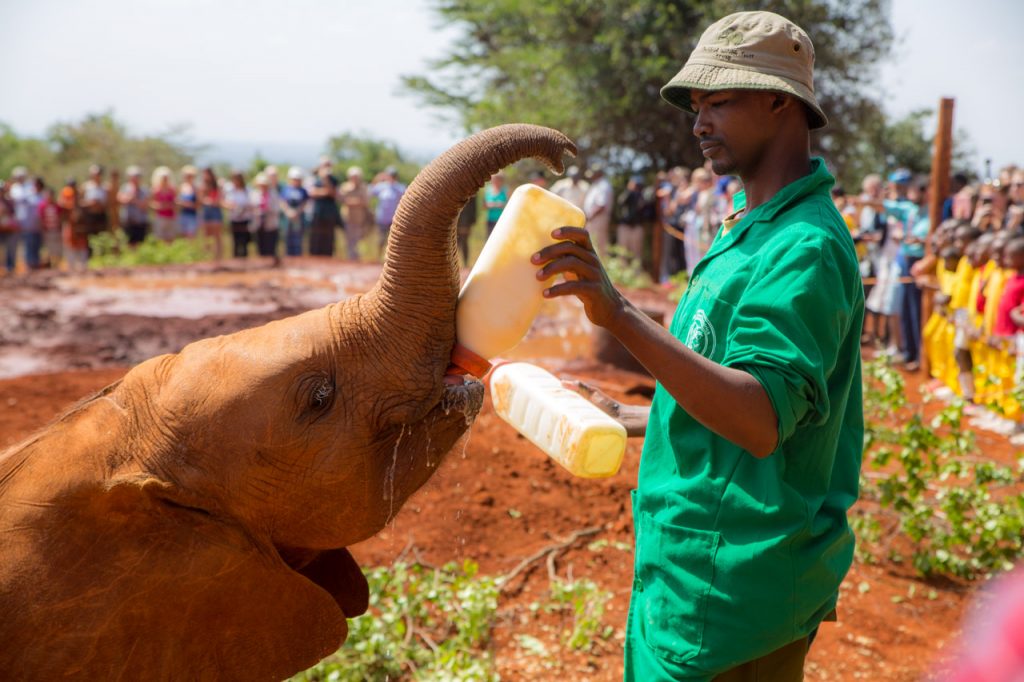

The curse of the ivory
Much to the amusement of the spectators, a small elephant begins to roll playfully in the mud. The rest will soon follow, the young elephants are enjoying life. Unfortunately, it has not always been this way. The elephants each have traumatic stories, and often poachers or fatal conflicts with humans are the reason they have come into care.
In 1979, it was estimated that there were around 1.3 million elephants in Africa. During the past 40 years, elephants have lost over 50% of their natural territories. Combined with the massive predation by poachers, the population has today been reduced to just below 400.000.
These are frightening numbers that underline the importance of the orphanage’s work – and remind us how privileged we are, as we next week will get up close with wild elephants and many other endangered animal species on our safari through Kenya. Some of the greatest experiences we have yet experienced in Africa lie ahead.


Safari in Noah’s ark
Two days later, we roll expectantly through the gate to the Samburu nature reserve in northern Kenya. Behind us is half a day’s drive through a magnificent and varied landscape. From Nairobi’s colourful throngs of people and densely trafficked streets, over a lush highland with endless orchards and Mount Kenya towering on the horizon, to a desolate and prairie-like semi-desert.
“ARE YOU READY FOR AN AFRICAN MASSAGE?”
The question comes from our safari guide, who has been our driver since we arrived in Nairobi. “Karibu”, he kindly welcomed us in Swahili at the airport and guided us to a large safari jeep. “My name is Noah and this is my ark.”
On board Noah’s vessel, we are bouncing on a rough dirt road. We are headed for Samburu Sopa Lodge, which is located inside the reserve and is an optimal starting point for the next few days of safari. Large stones, potholes, and sections with trenches make the jeep jump, dance, and shake as if we were driving on a washboard. Our bums are getting slapped, but our eyes are being rewarded with epic scenery.
The road meanders around small mountains, along brown rivers, and through scrub savannas with scattered vegetation of bushes, acacia trees, and tall palms. Bone remains are scattered here and there, and meter-high termite nests rise like tombstones from the dry earth. It is a picturesque – but harsh nature.

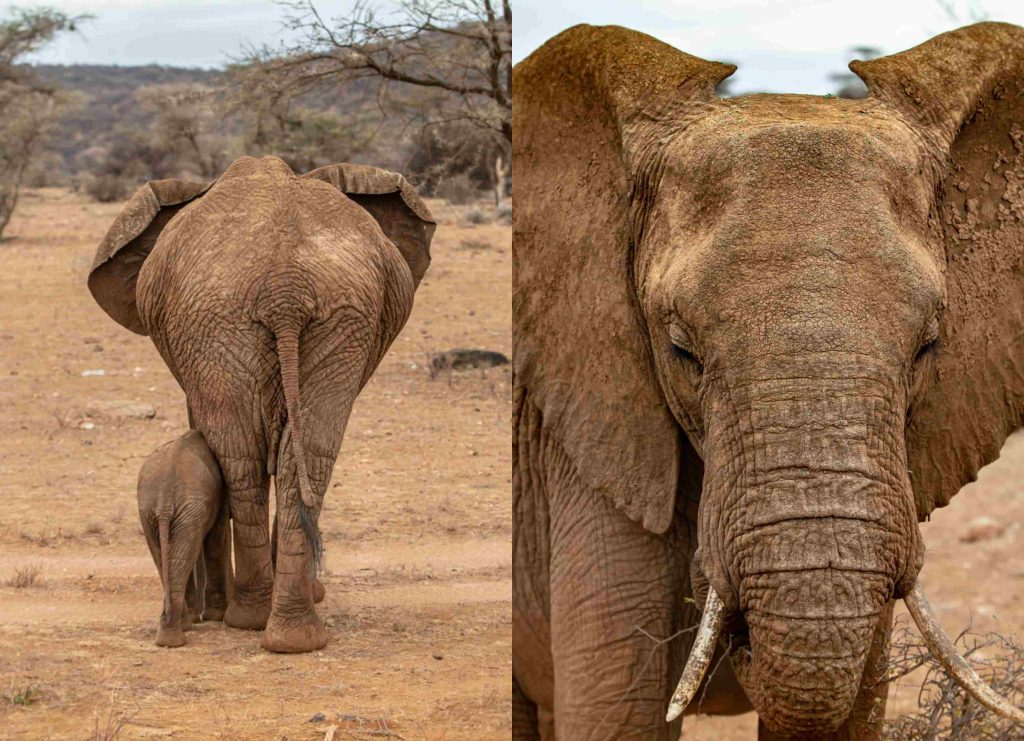

The wildlife of Samburu
We have not driven long before we cross paths with some of the animals that are endemic species to the area of Samburu. We catch a glimpse of a Somali ostrich before it takes off at highspeed on its blue legs, and two reticulated giraffes poke their heads up curiously from behind a tall bush.
At the edge of a thicket, a pair of giraffe gazelles are performing what looks like dog artistry. The caramel-brown Bambis balance on their hind legs and with their forelegs dangling in front of their chests, stretch their remarkably long necks to nibble the top leaves that other antelopes cannot reach.
Further on, Samburu’s more fashion-conscious residents appear. We greet a herd of Grevy’s Zebras, who are stylishly dressed in vertical and slimmer stripes than other zebras. But most striking is the large Beisa Oryx. With its long, pointed horns and cubist markings, the horse-like animal is reminiscent of a wandering Picasso painting.




The leopard and the lion gang
Both the air and our feelings swell with intensity. After a short rest at the lodge, we set off on an afternoon safari. Although it is our third safari trip, the joy of anticipation flutters in the diaphragm. Here nature commands the agenda. Emotions and eye activity go into hyperdrive every time Noah stops the jeep. “Can you see it?” he asks softly and points to a large tree, just a stone’s throw away.
There! Masterfully camouflaged in the shadow of the tree’s branches stands a leopard, and it clearly does not know the rules of Noah’s ark. The claws are drilled into the flesh of a lifeless dik-dik, Africa’s smallest antelope. The predator casts a stoic look at us, and licks its teeth, before again devouring a bloody chunk of its afternoon snack.
For a moment, all three of us sit as if frozen. Even for Noah, who has been a safari guide for two decades, seeing a leopard eat is a rare sight.



The adrenaline is still rushing as it is time to drive back to the lodge. The last rays of the day bathe the dry bushland in a honey-yellow light. Soon the sun leaves the endless firmament to the night’s twinkling stars. Martin is just about to say that the day couldn’t have been better when a powerful roar tears the air.
The chock makes us snap!
Suddenly, three full-grown male lions come leaping with great force. They pounce on a fourth lion accompanied by a lioness … surprisingly a few meters from the jeep. They tumble into the undergrowth. Branches break. A cloud of dust rises. Roars fill the air around us. And as quickly as they came, they are gone again. We exchange a burst of redeeming laughter. That was a close encounter!

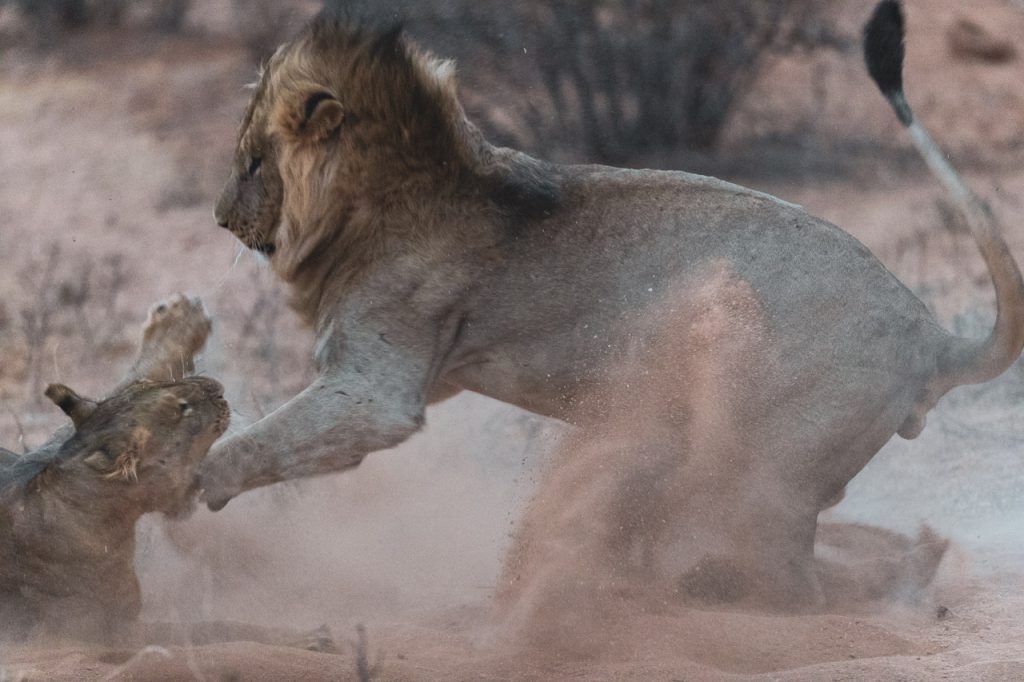
Naivasha – an african oasis
From Samburu, we drive further south and cross the equator on our way to Lake Naivasha. The freshwater lake is a lush center for Kenya’s billion-dollar flower production and is located in the middle of the Rift Valley. A gigantic gap that stretches over 5.500 km – from Mozambique in the south, up through East Africa, and north towards Jordan.
The fissure formations in the earth began 25 million years ago, and the area of Naivasha is one of the few places in the world where you can see the tremendous forces of Mother Earth with the naked eye. Smoldering volcanoes and steep cliffs testify to the continuing movement of the continental plates, and one day the land east of the rift will separate from Africa and form an island larger than Madagascar.
In the late afternoon we arrive at Lake Naivasha Sopa Lodge. A very idyllic place located right by the lake and we regret only having one night here. The main house is aristocratically furnished with walnut herringbone parquet and high wooden ceilings. Large, soft armchairs are placed in front of an open fireplace and a curved glass panorama with an enchanting view of the green garden. It calls for a cocktail!
But what makes the lodge so unique is not only the romantic atmosphere and the botanical surroundings. But the fact that we are sharing the place with the wild animals. A giraffe struts familiarly across the lawn, and a small herd of zebras graze a few meters from the pool – and I actually don’t know if it was Martin or the waterbuck with the big horns who were the most startled when they suddenly, face to face, looked into each other’s eyes on either side of a bush on the terrace. However, there is only one animal whom you must keep a respectful distance from.


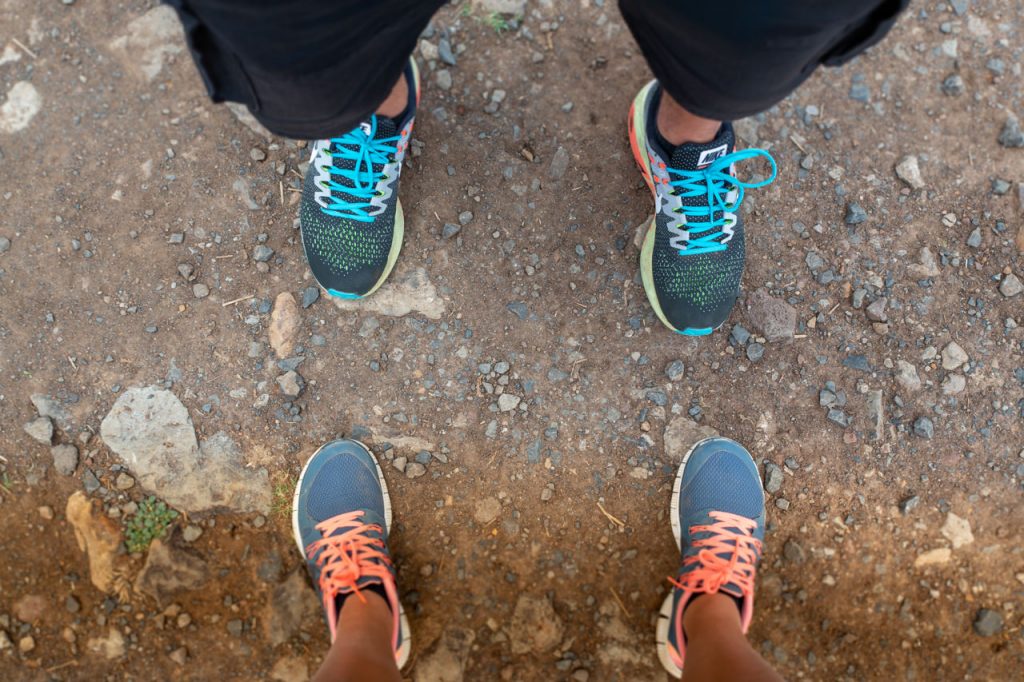
Hippos in the garden
“Perhaps you will survive if you run in a zig-zag,” the guard replies disturbingly cheerfully when we ask what we should do if we meet a hippopotamus? He has the task of following us safely from the lodge down to the hut after dark, when Africa’s most dangerous animals leave the lake to graze in our front yard.
The guard is armed only with a metal rod and the heroic-sounding name Nikodemus. Because the truth is, there’s not much you can do if you really piss off a hippo. And that is one of the reasons why the barrel-shaped hothead kills around 500 people every year. Fortunately, they stay on the other side of the huts. So, there is no danger, if you know where to go.
“LOOK, THEY ARE STANDING RIGHT THERE”.
The words make my heart skip a beat. Niko points out between two cabins. “Meet the world’s best lawnmower”, he laughs. The silhouette of three huge masses, in the process of doing the gardener’s work, is accompanied by a tactful sound. Ritch, ritch, ritch … The animals don’t care about us at all. They are busy gnawing their way through the 40-60 kg of grass that an adult hippo eats every night.
The next morning the hippos are gone, and the lawn looks like a perfectly mowed golf course. A little later we meet them again, but this time we are sitting in a small motorboat on Lake Naivasha. The ton-heavy animals slosh drowsily on the water’s surface, wiggle their ears, and hum deeply, like a symphony orchestra composed entirely of tubas. A farewell salute, perhaps? Because after the sailing trip, we wave goodbye to Naivasha and head for the journey’s last stop.


THE SAVANNAH OF LEGENDS
It is an intoxicating feeling as we enter the Masai Mara for the first time. In front of us the famous African savannah stretches as far as the eye can see, and on the horizon the umbrella-shaped acacia trees look like floating spots on the endless yellow-green grass plain. It is unbelievably beautiful!
The Masai Mara is the Kenyan part of the vast Serengeti savannah. An ecosystem that, taken together, is the size of Jutland in Denmark and contains the world’s largest concentration of wild animals. Here, Karen Blixen went on the famous safari trips with her beloved Denys Finch Hatton.
During the next few days, we see an impressive number of animals. Both the big and the small, the long-legged and the fat, the striped and the spotted. Those that eat grass and those that hunt other animals. All the while, we try to master the art of balance to stand up in the bumbling safari jeep to enjoy the view to the fullest through the open roof.

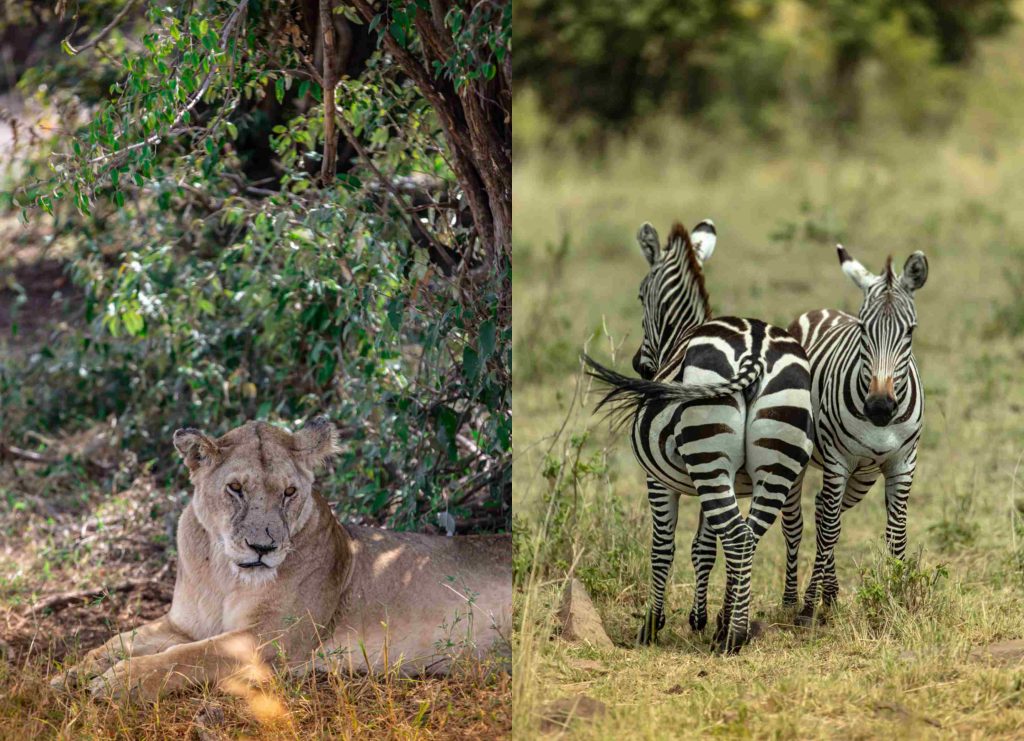




“He knows he looks like the ladies”, laughs Noah, as we drive past a topi, which rubs dirt on its horns in an attempt to stand out from the dark brown herd. Noah has many funny comments about the animals that he knows so well. He calls the warthog “The African Express”, and the small, fat pig does actually look like a busy messenger when it darts across the savanna with its tail sticking up in the air like an antenna.
The cheerful atmosphere takes a drastic change when Noah suddenly steps on the accelerator. Further on, two cheetahs are in a sprint after a young wildebeest. My heart pounds against my chest and we gasp for breath as the predator knocks the calf over. The seconds feel like an eternity. Miraculously, the wildebeest gets to its feet and runs off with a protective mother by its side. The hunt failed.
Things have gone differently for a lioness. She lies in a thicket with her three cubs and merrily slurps away the entrails of a dead wildebeest. A very abrasive stench tears in our nostrils, as we observe the consumption of a bloody spaghetti Bolognese of the savannah. Undoubtedly it smells heavenly to the predators. The next time we pass the wildebeest buffet, the vultures are fighting over the remains.


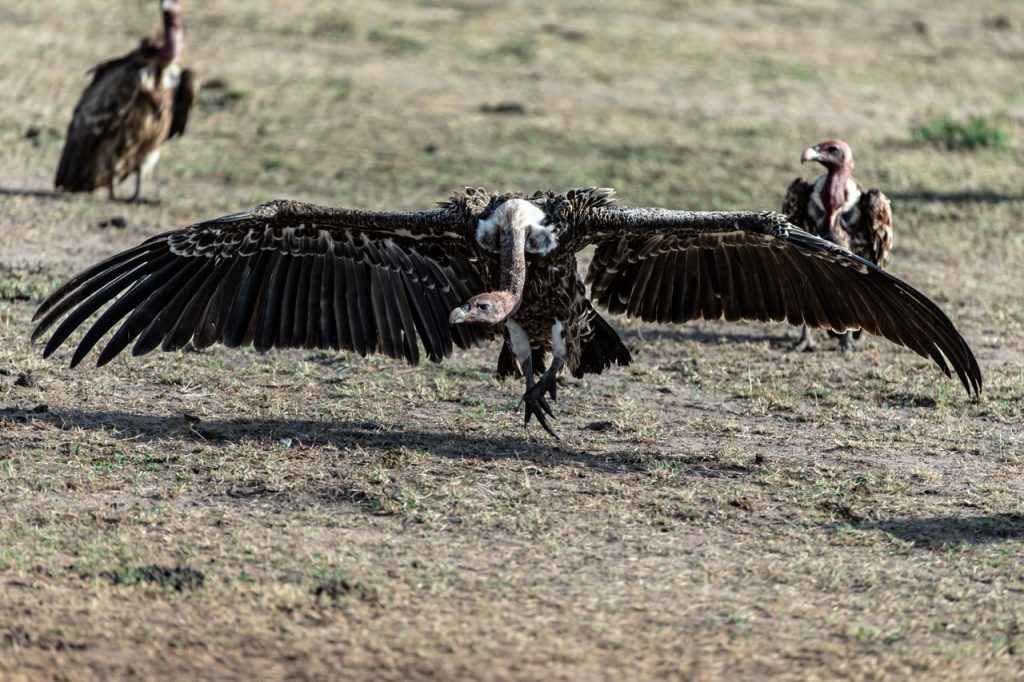

THE MARCHING SOLDIERS OF THE SAVANNAH
“I’ve heard that it’s started!”, Noah tells us with a big smile as we jump into his four-wheeled ark early in the morning. It’s our last day – and last chance to experience one of our biggest travel dreams. Every year during July, almost 2 million wildebeest and zebra cross the Mara River in their eternal circular migration in search of fresh grass. It is one of the world’s most spectacular natural phenomena.
The river is a few hours’ drive from the lodge, and the journey through Mara’s endless hilly landscape is wildly breathtaking. Here, life has been the same for hundreds of years. The certainty gives a breath of infinity. Time passes, but on the savanna, it stands imperceptibly still. Even the Maasai, the traditional red-clad tribal people, continue to live here – just as they did when Noah built his ark.
Suddenly, the first wildebeest begin to appear as grey-brown spots in the rolling sea of golden grass. Kilometer after kilometer the herd grows larger and closer, and the sound of their boating hum gets louder. The view is overwhelming. It is difficult to comprehend the large number of animals that cover the vast plain. “The crossing might happen in a little while”, says Noah and picks up the pace. A radio call reported that a large herd of animals has gathered at the river’s edge.
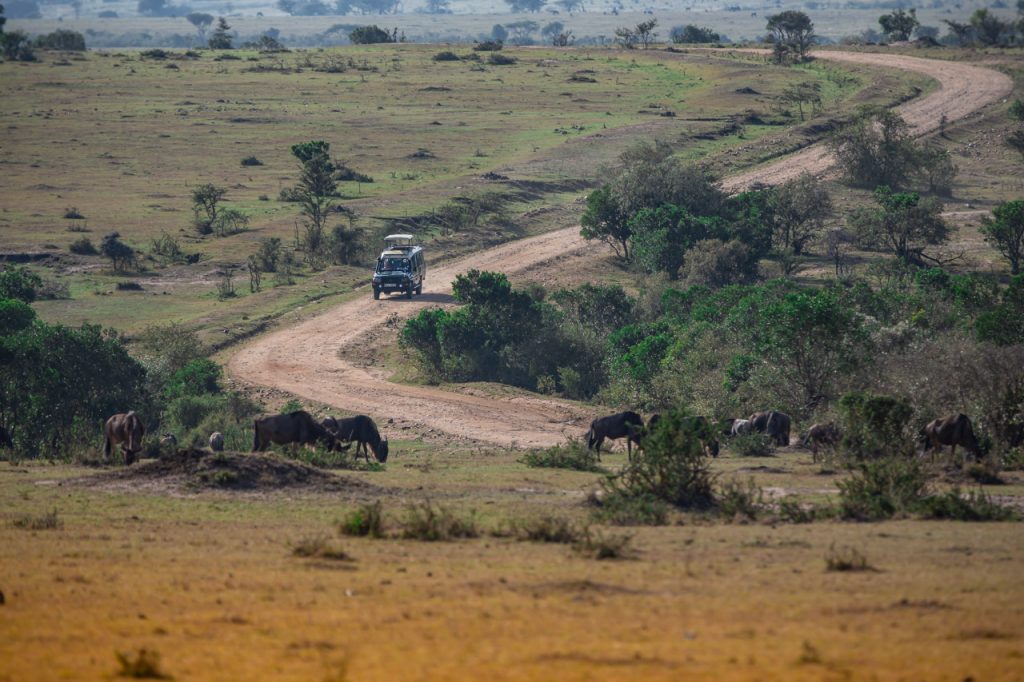

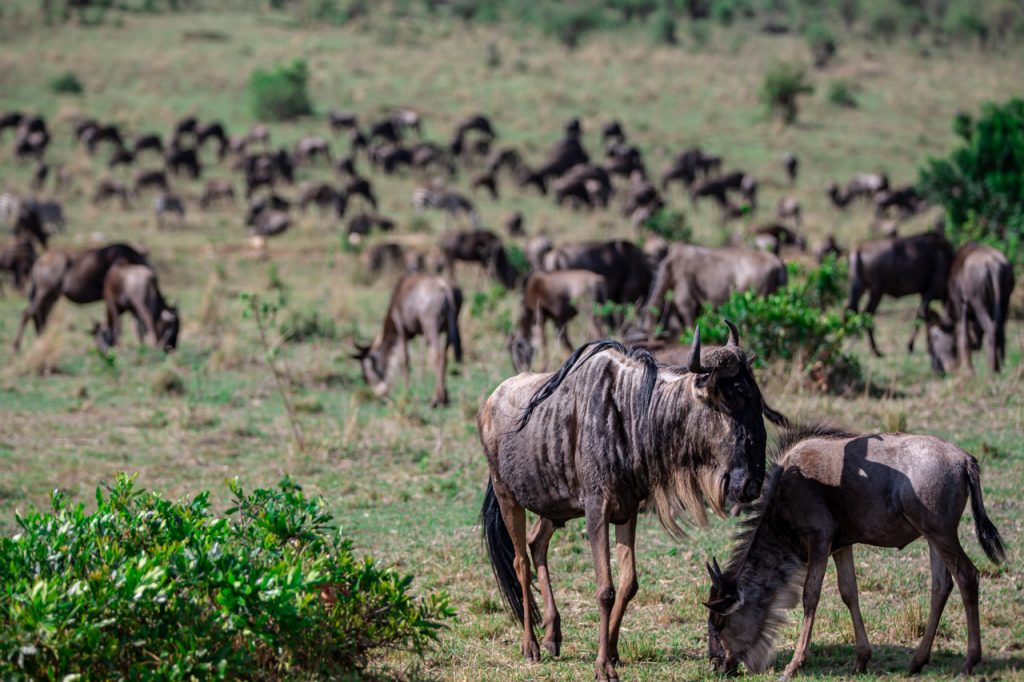
NATURE’S SLAUGHTER BENCH
Just over 20 safari jeeps line up neatly by the river, like a mobile tribune with expectant spectators. A good distance away, several hundred wildebeests and zebras trip restlessly about. The strategy is for the cars to stay at a distance to not frighten the nervous animals and then quickly drive to the river when they start jumping into the water.
At first glance, none of the animals seem to dare to take the first leap, and we wait in uncertainty as to whether they will even cross the dangerous waters today. But when they start, it will be a fight to the death. The crocodiles are not the only danger lurking beneath the surface. The raging current of the river can drown the animals, or they can be trampled to death under hundreds of hooves.
“Now!” Noa starts the jeep and with a jerk we and the other cars drone towards the river, where the first wildebeest have moved down to the edge. Like lemmings, more follow as panic sets in along the riverbank. The masses press the animals at the front, who jump splashing into the muddy brown water. The water whips up under the hooves, and the wildebeest’s deep roar forms the soundtrack to the dramatic scene.

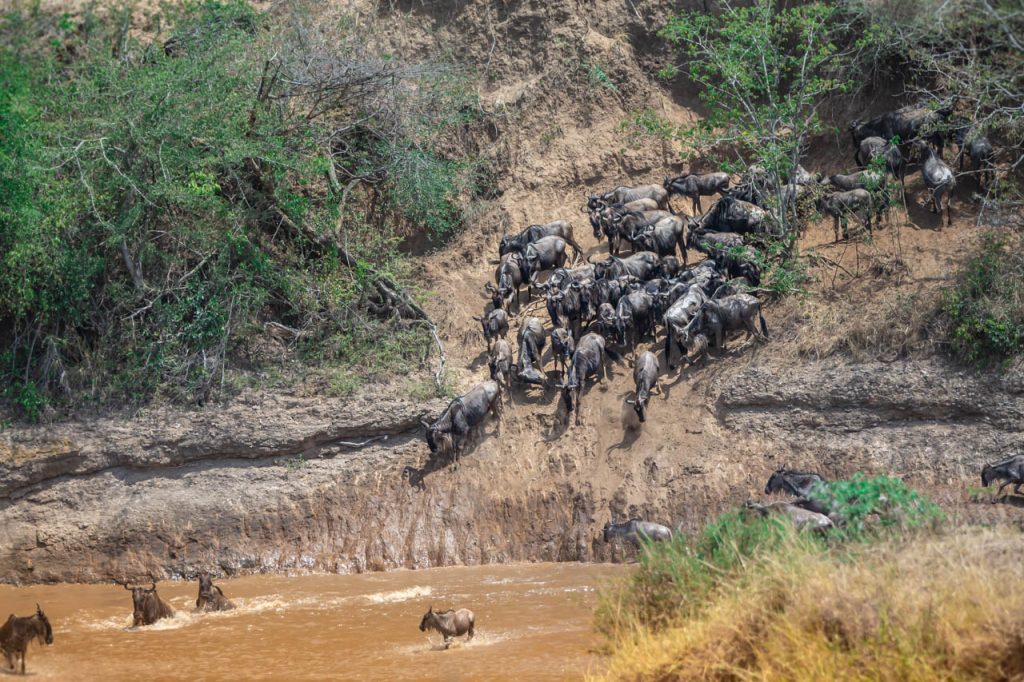

The first animals gain a foothold on the opposite bank. With awkward leaps and wobbly legs, they try to climb the steep slope. Two wildebeest tumble backwards, dragging several with them into the fall. Others struggle helplessly, but their legs break in the wet mud of the slope. More and more animals come jumping out of the water. They pile on, topple over, and slide backwards. It’s chaos!
A little further on, a group has found a better place to land. They jump up the slope and continue away from the river. In a long march, the animals wander on. They survived the crossing of the river, but wander on as a huge buffet for the predators awaiting their arrival on the savannah …
For us, it is time to leave. But the thought that thousands of animals will cross the river over the next several days makes a big impression. We have seen male lions fight, leopards eat and cheetahs hunt. Experiences that are among the rare ones on a safari and which are usually only seen in the animal programs on TV. But the migration was nevertheless something very special.
It’s a wild experience that we will never forget.

FACTS ABOUT THE JOURNEY
We traveled in July 2017 and the trip was booked through Afrika-Safari.dk, who was very helpful with everything both before and during the trip. They organized the program and booked all our trips. The journey began in Nairobi, where we stayed 2 nights and, among other things, visited Karen Blixen’s farm and the elephant orphanage. After that we drove to Samburu, where we had 3 nights, and then a single night at Lake Naivasha, before we drove to Masai Mara. The trip ended with a beach holiday in Mombasa.
Useful links
- National Geograhic: Article on the Elephant Orphanage in Nairobi
- Travel tips for safari: Packing list, photo equipment and experiences

